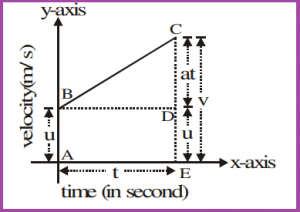So we come to the main topic of motion that is graphical representation of equation of motion. In this section we will learn, how we will established the equation of motion graphically. For that, in my previous post we learned about how we can plot ” Distance time graph ” and ” Velocity time graph “.
Let we see in this post how we can established equation of motion graphically. Here we can see how easily we can prove all laws of motion graphically.
- v = u + at
- s = ut +
at2
- v2 = u2 + 2as

Here in above diagram, as we see it is a velocity-time graph BC, in which AB represents the initial velocity u, CE represents final velocity v, such that the change in velocity is represented by CD, which takes place in time t, represented by AE. From above diagram we can easily understand graphical representation of equation of motion.
Derivation of v = u + at
As we know the slope of a velocity time graph represents acceleration.
So we can say,
Acceleration = slope of the graph line BC.
v – u = at
v = u + at
Derivation of s = ut + at2
at2
The area enclosed by velocity time graph represents distance.
so,
Distance traveled = Area of trapezium ABCE =
Area of rectangle ABDE + Area of triangle BCD
= AB × AE +(BD × CD) = t × u +
[t × (v–u)]
= ut + [t x at]
S = ut + at2
Derivation of v2 = u2 + 2as
As we know, the area enclosed by velocity time graph represents distance.
so,
From the velocity-time graph distance covered = Area of trapezium ABCE
⇒ S = (AB + CE) × AE
S = (u + v) × t …………………………….(i)
Substituting the value of t in eq (i)
S =
S =
v2 – u2 = 2as
Finally here you can see complete video lecture on graphical representation of equation of motion for CBSE class 9 students.
Let’s check how you learn Graphical Representation of Equation of Motion ?
[WpProQuiz 6]




